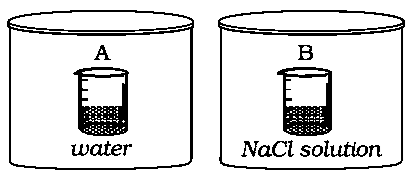Two beakers of capacity were taken. One of these beakers, labelled as , was filled with water whereas the beaker labelled was filled with of solution of . At the same temperature, both the beakers were placed in closed containers of the same material and same capacity as shown in Figure.

At a given temperature, which of the following statement is correct about the vapour pressure of pure water and that of solution.

At a given temperature, which of the following statement is correct about the vapour pressure of pure water and that of solution.
container .

Important Points to Remember in Chapter -1 - Solutions from NCERT NCERT Exemplar Chemistry - Class 12 Solutions
(i) Solution is a homogeneous mixture of two or more chemically non-reacting substances whose composition can be varied within certain limits.
(ii) Solute and Solvent. In a binary solution, the component present in smaller amount is called solute while the other present in larger amount is called solvent. If water is the solvent, solution is called aqueous solution.
2. Concentration terms of solutions
(i) Molarity
(ii) Molality
(iii) Mole fraction
(iv) Mole fraction of solutemole fraction of solvent
3. Laws governing solutions:
(i) Henry’s law: The mass of the gas dissolved in a given volume of the liquid at constant temperature is directly proportional to the pressure of the gas in equilibrium with the liquid or for a mixture of gases in equilibrium with a liquid, the partial pressure of the gas is directly proportional to the mole fraction of the gas in the solution
or
is Henry’s law constant.
(ii) Raoult’s law in its general form can be stated as, for any solution the partial vapour pressure of each volatile component in the solution is directly proportional to its mole fraction.
4. Colligative properties:
(i) Relative lowering in vapour pressure:
and
(ii) Elevation in boiling point and
(iii) Depression in freezing point and
(iv) Osmotic pressure or and
5. Van't Hoff factor:
(i)
(ii) Relative lowering in vapour pressure
(iii) Elevation in boiling point,
(iv) Depression in freezing point,
(v) Osmotic pressure,
